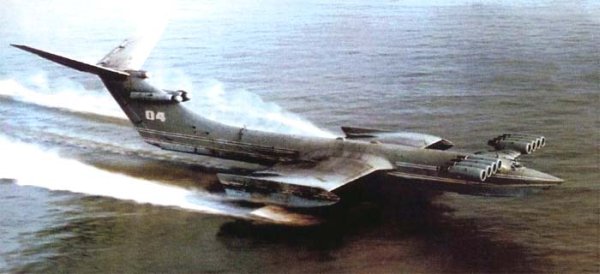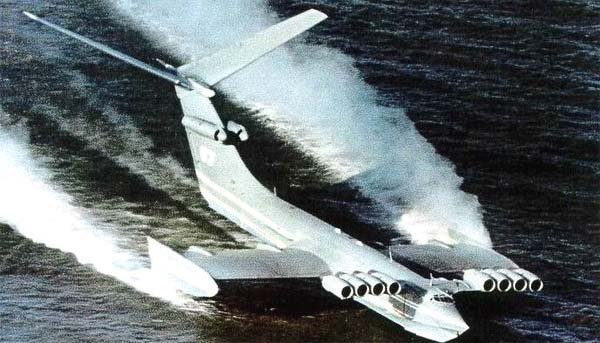Updated: December 20, 2014
If you're wondering what ekranoplans are, they are also known as Wing-in-Ground (WIG) effect vehicles and Ground Effect Vehicles (GEV). In other words, ekranoplans are a bastard concept that does not fit any one conventional category easily. Not a plane, not a ship, not a hydrofoil, not a hovercraft, not anything. But the closest analogy would be: big, heavy low-flying aircraft.
Yes, ekranoplans are fascinating because of the whole range of physics and technology concepts that they so deceptively cover, as well as the practical usage they could have. Imagine a transportation vehicle that lands on the sea, just like a conventional seaplane. But it is not a seaplane, because its flight range is mostly restricted to very low altitudes above the sea, in fair weather conditions. Then, size-wise they are like ships, only much faster. Finally, they might also be used over the ground, making them just like ordinary aircraft. Confused? Good.

Technology
The reason I wanted to explore and discuss ekranoplans is that they represent an understated technological achievement that has not seen wider use in modern transportation. Think about it. You want to from one place to another, and the travel requires crossing a big body of water, like a sea or an ocean. You have two options there. You can fly between two airports, or use a ship to cruise from one harbor to another.
Ships are big, comfortable and utterly slow. Planes are fast but quite expensive, they carry a very light load, and they cannot make use of the vast water surface. Now, imagine if you could take off from London at about half the expected flight speed, remain at very low altitude, just a few meters above the waves, alight in the middle of the ocean for refueling and refreshments, then continue your would-be sea-skimming flight to New York. You'd arrive a little later compared to your typical airlines, but you'd have had most of the comfort of sailing on a ship.

Now, what if you need to transport big, bulky loads. Aircraft are rarely an option for that. So you load large cargo ships, and then you wait a few weeks until they complete a journey. Finally, what if there's a problem with your flight for some reason, can the pilot safely land somewhere in the vast ocean? Not bloody likely.
Combine all these requirements and risks. And then mitigate them with a single solution. It comes out as a hybrid concept that allows for great payload, comfort, speed, and safety. The answer is, ekranoplans. All right, sounds marvelous, so then, why aren't we using them en masse?

Limitations
GEV do have a bunch of problems. Maintaining flying at low altitudes takes more fuel than one performed in the stratosphere. This means that a typical ekranoplan cannot complete a transcontinental journey in one go, and it would have to stop for refueling. For example, the ex-Soviet LUN had a range of about 1,900 km, while the smaller A-90 Orlyonok can travel 1,500 km. So we would need fuel stations and bistros placed in the middle of the ocean, plural there, oceans, probably in the form of oil-like rigs and such.
Then, ekranoplans need calm seas to operate, so their usage is probably restricted to specific seasons and locations. It also makes senses to use them in less open seas, but it's the ocean mid-point stopovers that would pose the big practical challenges. Last but not the least, let's not forget the price. The necessary design changes and the manufacturing of materials sturdy enough to support WIG use makes this kind of vehicles more expensive than common aircraft per cargo unit.

Note: Image taken from Wikipedia, licensed under CC BY-SA 3.0.
Still, despite all that
I do believe that there's untapped transport potential hidden here, probably offset by the relatively low need to challenge the existing status quo. If you think about it, a huge amount of effort is invested in making aircraft safer, which is a good thing. But if you're flying in a WIG, at only a few meters of altitude above the sea level, and you encounter a problem, then you have an endless airstrip anywhere around you. In itself, that is a worthwhile safety prospect.
Furthermore, think of the trans-oceanic commerce. Imagine people being able to step out of the plane and stretch. Maybe go shopping on one of the refueling rigs, do some duty free spending. Or maybe go sea diving and such. The touristic and commercial possibilities are endless. Such things are not possible with standard aircraft, and the ships do offer them, usually at a very high price and slow speed. But if you could complete a transatlantic flight in two days with a stopover at a casino in the middle of the ocean, at a fraction of a price of a nice seagoing cruise, would you not do that?

Note: Your middle-of-the-ocean hotel; image taken from Wikimedia, licensed under CC BY-SA 2.0.
Another great advantage of ekranoplans and family is that they could use any naval port or any shore as their bases of operation. You do not really need expensive airports, and this is a huge benefit. Cheap infrastructure, readily available.
Finally, the ability to lug ultra-heavy cargo at 20x the speed of a large ship. That could be awesome. Critical drilling equipment, special machinery, even military materiel, could be ferried across great distances at near-plane speeds and near-ship cargo displacements. Sure, we would have to make our seas allow for friendly stopovers, but is it not high time to start doing just that? Think about it. 70% of Earth's surface is simply unused in any sense. If you leave the shore, you're more or less on your own, for thousands of kilometers. But what would happen if you knew there was a hotel every five hundred kilometers, no matter where you go. A hospital? A shopping mall?
Conclusion
I am still trying to figure out why ekranoplans have not taken off [sic]. I believe part of it has to do with the sheer magnitude of the technological change, which is too radical to accept on a mass scale. Furthermore, most of it was kept obscure and secret due to military use, but now, there's a pretty good opportunity to revive the various projects and make them cheaper, more easily available and more profitable.
So there we are. WIG, GEV, ekranoplans, call them what you will, they are the ultimate transportation device. But they are so far-fetched that countries are simply not willing to risk going there, not when you can pack people like sardines into airliners, or charge tens of thousands of dollars for an easygoing sea cruise. But there's this fine and crazy technology, crammed with goodies, waiting to be unleashed. Speed, payload, safety, convenience, mastery of the seas, like proper. So there we are. Food for thought.
Note: Images of ekranoplans, unless noted otherwise, from Soviet Navy archives.
Cheers.